Nature-friendly wood-chip pavement
- Forest Experience Zone, Seto Terminal, Mitsubishi Pavilion @Earth etc. -
Visitors to EXPO 2005 Aichi, Japan will initially find that wood is used everywhere around the Exhibition site. The forest zone accounts for approximately half the entire EXPO site, creating a situation suitable for a world exposition focused on harmonious coexistence with nature. Here, you can see that wood is not used only for buildings. Now let us present an exmaple of wood being used also for pavement.
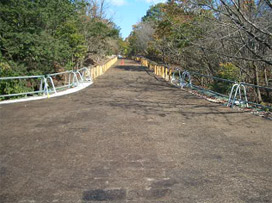
Promenade of Nature School Forest
At about four locations on the Site, a nature-friendly pavement called “wood-chip pavement” has been built, featuring a new technology. Visitors can walk on this pavement to realize how it feels. The wood-chip pavement has been made of waste wood, including timber from forest-thinning to construct the Exhibition site. The new techology enabled recycling of such waste wood, which conventionally has been disposed of by incineration. First, waste wood materials are crushed into chips of 5 cm or less. These chips are then placed in a mold and subjected to high-pressure steam processing at 180°C for about 30 minutes, and pressed into a pavement board. Theoretically, in this process the crystal structure of the cellulose contained in wood is changed, causing permanent deformation (shape memory) of the chips. As a result, wood chips can be pressed into a desired shape, as they become intertwined with each other. This is an eco-friendly technology that uses natural wood alone, with no chemical substances at all.
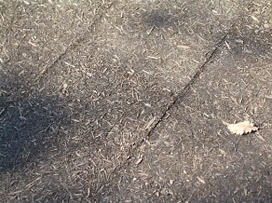
Enlargement of wood-chip pavement surface
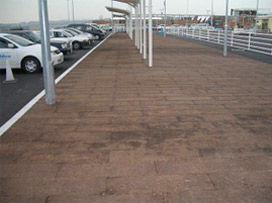
Seto Terminal
The wood-chip boards used for pavement on the EXPO site are 30 cm x 50 cm x 3 cm in size. Moderately soft, the pavement is extremely comfortable to walk on, and has earned a favorable reputation among many people. Thus far, soft pavements, or more precisely “elastic pavements,” have been subjected to various studies to identify the ideal surface hardness that ensures safe and comfortable passage of users. According to the study results, the EXPO site's wood-chip pavement, whose impact acceleration is 80 ± 10 G, realizes the optimal surface hardness. Wood-chip pavement features include the following:
- Environmental friendliness; made of natural wood only.
- Safely decomposes and returns to soil, without having negative impact on the environment.
- Excellent water-retaining capacity, helps heat-evaporation effect last longer.
- “Softness” is safer for walkers even if they fall.
- Degree of hardness designed to be easy to walk on.
- Degree of hardness designed to be easy for wheelchair use.
An experimental research project headed by the Faculty of Applied Biological Sciences, Gifu University, is under way to prevent the spread of desertification and facilitate desert greening by using wood-chip boards to pave around a desert in Ghana. As exemplified by this project, various international activities have been conducted in pursuit of harmonious coexistence between nature and humankind.
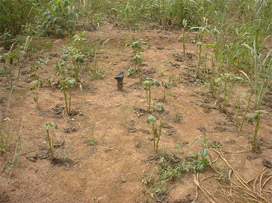
Area where wood-chip board is not used
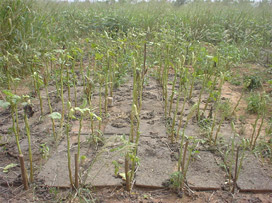
Area where wood-chip board is used (in Ghana)


